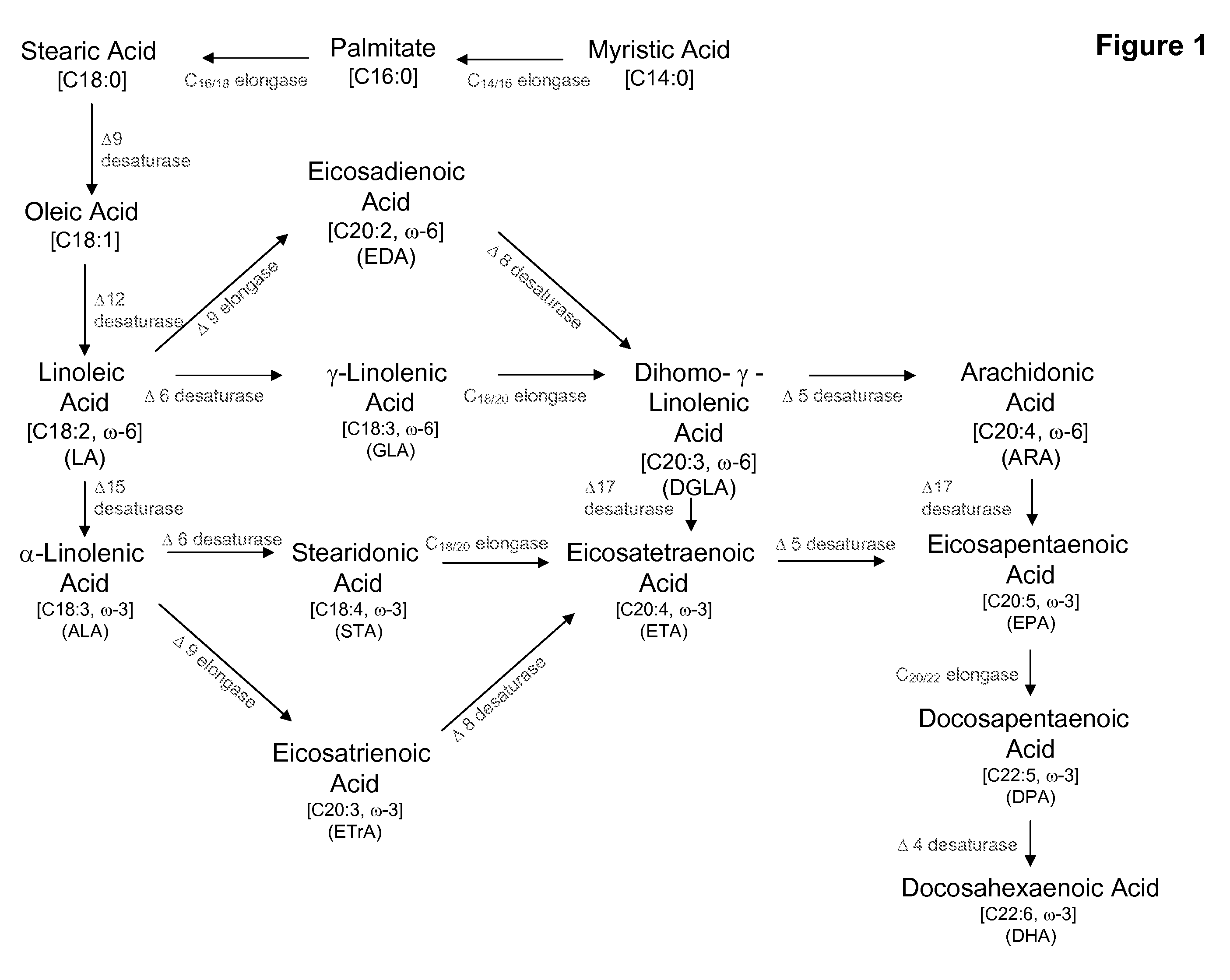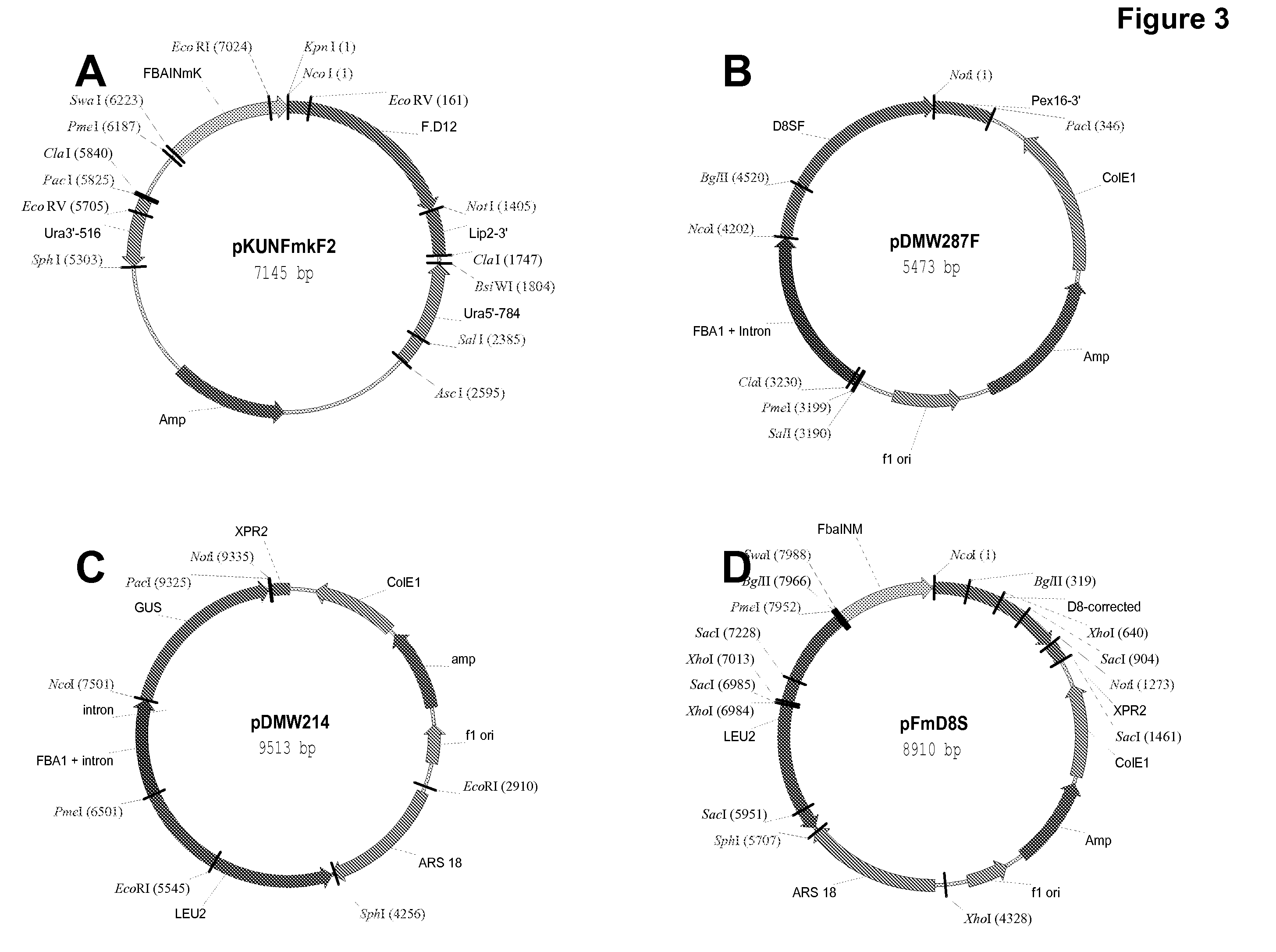Delta17 desaturase and its use in making polyunsaturated fatty acids
- Summary
- Abstract
- Description
- Claims
- Application Information
AI Technical Summary
Benefits of technology
Problems solved by technology
Method used
Image
Examples
example 1
Pythium aphanidermatum Lipid Profile, Total RNA Isolation and Genomic DNA Isolation
[0244]A Pythium aphanidermatum strain was obtained from Lisa Hoffman (E.I. duPont de Nemours, Inc., Wilmington, Del.).
[0245]The strain was grown on malt extract agar medium (Difco Laboratories, Detroit, Mich.) at room temperature for 3 days. Cells were scraped off the plate and resuspended in 600 μl of sodium methoxide dissolved in methanol. The sample was shaken for 20 min, and 50 μl of 1 M NaCl was added. After mixing, 600 μl of heptane was added. The sample was vortexed and centrifuged in an Eppendorf microfuge for 1 min. The upper layer was carefully separated from the lower layer and placed in a glass vial for GC analysis. The results of the analysis are shown below in Table 4. Fatty acids are identified as 16:0 (palmitate), 16:1 (palmitoleic acid), 18:0, 18:1 (oleic acid), 18:2, GLA, 20:1, 20:2, DGLA, ARA, EPA and DHA; and the composition of each is presented as a % of the total fatty acids.
[024...
example 2
Pythium aphanidermatum cDNA Synthesis
[0251]Double-stranded cDNA was synthesized directly from the Pythium aphanidermatum total RNA using the BD-Clontech Creator™ Smart™ cDNA library kit (Mississauga, ON, Canada). Specifically, 3 μl of total RNA sample (0.9 μg) was mixed with 1 μl of SMART™ IV oligonucleotide (SEQ ID NO:9) and 1 μl CDSIII / 3′ PCR primer (SEQ ID NO:10). The mixture was heated to 75° C. for 5 min, and cooled on ice for 5 min. Two (2) μl of 5× first strand buffer, 1 μl of 20 mM DTT, 1 μl of dNTP mix (10 mM each of dATP, dCTP, dGTP and dTTP) and 1 μl of PowerScript reverse transcriptase were added to the mixture. The sample was incubated at 42° C. for 1 hr.
[0252]The resulting first strand cDNA synthesis mixture was then used as template for PCR amplification. The reaction mixture contained 2 μl of the above first strand cDNA sample, 80 μl of water, 10 μl of 10× Advantage 2 PCR buffer, 2 μl 50× dNTP mix (10 mM each of dATP, dCTP, dGTP and dTTP), 2 μl of 5′ PCR primer (SEQ ...
example 3
Isolation of a Portion of the Coding Region of the Pythium aphanidermatum Δ17 Desaturase Gene
[0254]The present Example describes the identification of a portion of the Pythium aphanidermatum gene encoding Δ17 desaturase (designated herein as “PaD17” (SEQ ID NOs:1 and 2)), by use of primers derived from conserved regions of other known Δ17 desaturase sequences.
[0255]The P. aphanidermatum cDNA sample from Example 2 was used as template for PCR using degenerated primers designed to amplify portions of the potential Δ17 desaturase gene, based on the Δ17 fatty acid desaturase sequences of Phytophthora sojae (SEQ ID NO:45; U.S. patent application Ser. No. 11 / 787,772, filed Apr. 18, 2007; see also Example 11, infra) and Phytophthora ramorum (SEQ ID NO:47; U.S. patent application Ser. No. 11 / 787,772, filed Apr. 18, 2007; see also Example 13, infra). Based on the alignment provided herein as FIG. 2, degenerate primers were designed as shown in Table 5 (location of primers with respect to SEQ...
PUM
| Property | Measurement | Unit |
|---|---|---|
| temperature | aaaaa | aaaaa |
| temperature | aaaaa | aaaaa |
| temperature | aaaaa | aaaaa |
Abstract
Description
Claims
Application Information
 Login to View More
Login to View More - R&D
- Intellectual Property
- Life Sciences
- Materials
- Tech Scout
- Unparalleled Data Quality
- Higher Quality Content
- 60% Fewer Hallucinations
Browse by: Latest US Patents, China's latest patents, Technical Efficacy Thesaurus, Application Domain, Technology Topic, Popular Technical Reports.
© 2025 PatSnap. All rights reserved.Legal|Privacy policy|Modern Slavery Act Transparency Statement|Sitemap|About US| Contact US: help@patsnap.com



